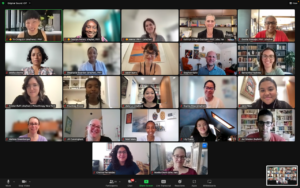4 min read
Leading Narrative Change

Activists, philanthropists, and social entrepreneurs increasingly are focused on influencing people and shaping opinions, behaviors, and policy through narrative. There’s also an increased focus on culture change through narrative.
Although the definition of the word can be nuanced, narrative generally refers to the big, overarching stories that result from the amalgamation of smaller stories. As the Narrative Initiative puts it: “What tiles are to mosaics, stories are to narratives.”
Liz Manne and Erin Potts, co-founders of A More Perfect Story, offer another practical analogy to guide our understanding:
- Stories are stars.
- Narratives are constellations of stars.
- Culture is the galaxy which contains the stories and narratives.
Just like constellations are groupings of stars that help us organize our understanding of the night sky, stories are assembled into narratives to more efficiently transmit our beliefs and collective meaning.
Brett Davidson, in “The Role of Narrative in Influencing Policy,” offers this explanation of narrative change work:
“Narratives embody fundamental assumptions by which we interpret and understand the world. Because they constitute the culture in which we live, we are often unaware of these assumptions and the narratives through which they are conveyed. Therefore we need to find ways to reveal, challenge and change them.”
Working with story and narrative is different than working with messages. Working with story and narrative is multi-directional and requires active listening, a willingness to invite participation, and comfort with complexity. Today, leaders of nonprofit organizations have multiple channels for both communicating and listening, and audiences are increasingly distracted and fragmented. Working with story and narrative therefore requires leaders to be intentional about which stories to look for and share, and to select for the narratives they want to influence.
If you already are, or are interested in, leading an effort to create change through narrative (either within an institution or in the larger culture), you need to model sincere respect for the hard work involved in finding, making sense of, and sharing stories. You must demonstrate your commitment to narrative change. And, to be a true narrative leader, you must uphold the highest ethical standards.
Here are some questions to guide you, and your teams, as you engage in story and narrative work on the road to becoming “narratively” competent:
- Do you appreciate the fact people around you make sense of their world through story? Are you committed in your own efforts to see your world through a narrative lens?
- In your own work, are you focused on both the aspirational Big Story (i.e., the narrative), as well as the smaller stories that reinforce the narrative and help drive the movement for change? How are you inviting and motivating people to participate in and contribute to your preferred or chosen Big Story?
- How are you listening — and making sense of what you hear? What themes are emerging in your listening? What stories are leading to engagement?
- What are you doing to make sure you’re not ignoring what is being said, or voices that may not be coming through in your listening? What are your checks for ensuring that you are not listening only to what you want, or think you need, to hear?
- How do you include, invite, and encourage participation in your organization’s narrative and story work — from participants at every level of power and access?
- What is your understanding of how narrative is woven through complex systems? Are you recognizing, encouraging, and evaluating cultural, structural, and community narrative efforts?
- Have you clearly articulated your organization’s understanding of and commitment to ethical approaches to inclusion, representation, and permission?
- Are you taking a long view to narrative change and cultural shift, realizing that stories and narratives are constantly emerging?
- What does it mean to you to be leading an organization committed to narrative change?
- Are you committed to the journey and not the product?
You want to picture your organization, its work, and the work of your allies (and opponents) as facets to be assembled, kaleidoscope style, into compelling patterns. As a change leader, you have the opportunity, responsibility, and power to influence how they come together.







